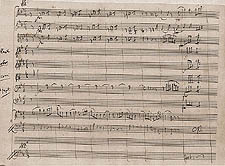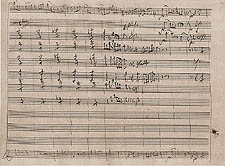Fair-Copy Full Score
![]()
When completed, the full score of a concerto served as the source for
a copyist to extract a set of parts, which Mozart used for his performances.
Mozart sometimes had AN EXTRA SET of parts made for his sister or one
of his best students (for instance, Barbara Ployer or Josepha Auernhammer)
or a paying patron. In the present case he also apparently had a business
arrangement with the Viennese music-copying firms of Lorenz Lausch and
Johann Traeg to sell sets of parts, which were advertised in the Wiener
Zeitung.
Constanze Mozart sold the autograph scores of the keyboard concertos to the Offenbach music publisher Johann André in 1799-1800, and gave Mozart's own sets of parts to their pianist-composer younger son, Franz Xaver (W. A. Mozart fils); the latter are unfortunately lost.
![]()
Wolfgang Amadeus Mozart. Facsimile of the beginning of
the Finale of K. 450 from the autograph fair-copy full score. This manuscript
is owned by the Herzogin Anna Amalia Bibliothek, Weimar
![]()

Copyright
© 2002 Division of Rare & Manuscript
Collections
2B Carl A. Kroch Library, Cornell University, Ithaca, NY, 14853
Phone Number: (607) 255-3530. Fax Number: (607) 255-9524
For
reference questions, send mail to:
rareref@cornell.edu
If you have questions or comments about the site, send mail to: webmaster.

